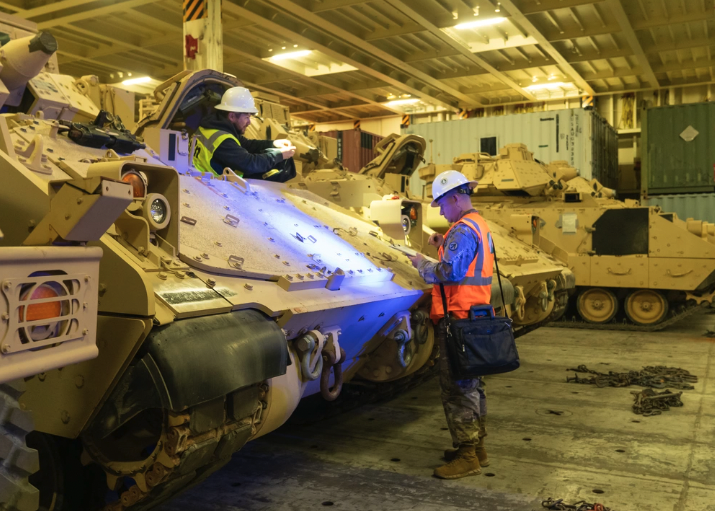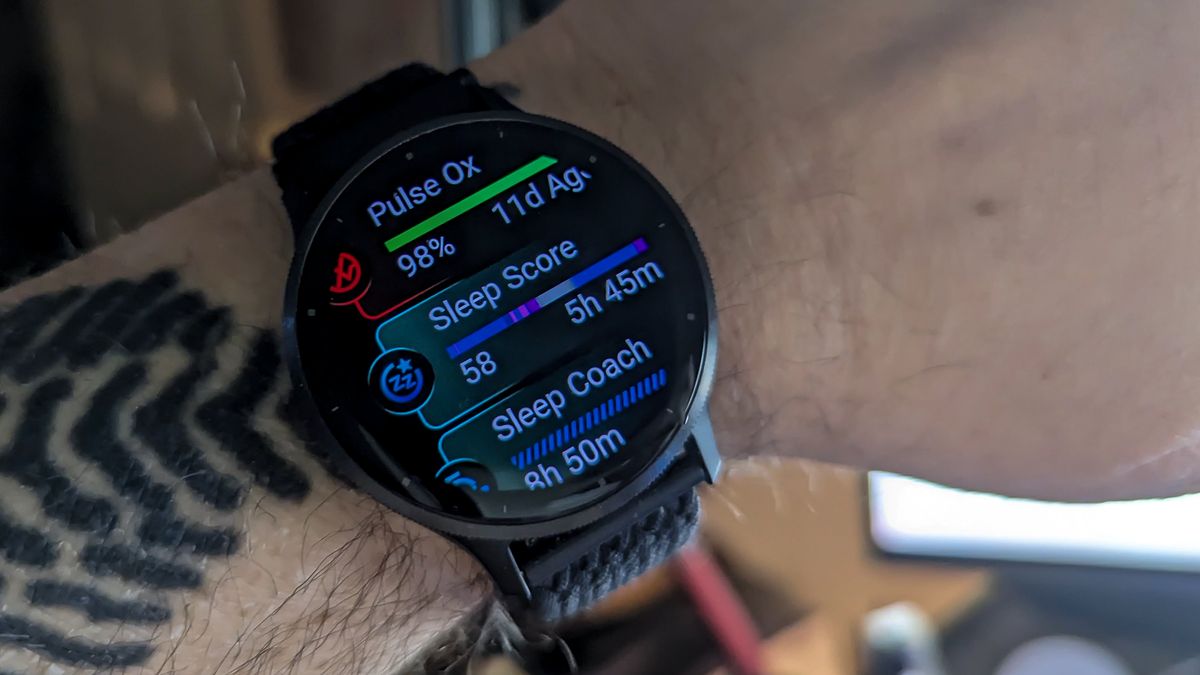World
How Transcom transformed to ‘rapidly adapt as things change around the world’

With digital dashboards and analytics tools that integrate real-time military data and depict operational assets and potential threats, U.S. Transportation Command now has unprecedented visibility into the Pentagon’s vast arsenal of weapons and personnel it moves around the world for deployments, crisis response and high-priority missions, two senior officials told DefenseScoop.
The command is increasingly tasked with executing global operations in and around contested environments, like in the Red Sea, where Iranian-backed Houthis are launching missiles and drones in attempts to close the sea line of communication as a response to Israel’s conflict with Hamas in Gaza.
“When we’re looking at any types of disruptions throughout the Red Sea, we’re able to identify what type of critical missions we’re supporting. We can identify what types of ships they were on, and then — from a Transcom perspective — be able to identify what type of cargo was on those ships, and potentially how it could impact our missions,” Marine Corps Maj. David Costanzo, deputy chief of Transcom’s Operations Integration division, said in a recent interview with DefenseScoop.
Strategic moves Transcom started making almost 7 years ago to better understand and organize all of its sprawling internal and external data sources and apply analytics capabilities to inform decision-making are now having direct impacts on those current operations.
Maj. Costanzo and Transcom Chief Data Officer Markus Rogers briefed DefenseScoop on the command’s evolving ability to rapidly tap into data and deliver digital tools that support and enhance worldwide military transit and operations — including custom dashboards that monitor and visualize U.S. security posture, among other workflows. While the Transcom officials couldn’t share specific details about the dashboards, like their names, they were able to “talk about kind of what they’re really providing,” Costanzo explained.
The pivot
After serving as a longtime networks and integration leader primarily for the Air Force, Rogers joined Transcom in 2019 as its first-ever chief data officer.
Alongside Costanzo in the interview, he told DefenseScoop that his top aim in this capacity continues to be ensuring that command officials “have the right data, at the right time — and that they can understand and trust — in order to make decisions.”
“Transcom has been, I’ll say, on this ‘data journey’ for a very, very long time. We are, by our very nature, that information broker type of organization in the way that we support all the combatant commands. So, the data journey is not new to us,” Rogers explained.
Around 2018, the command started to fully grasp the emerging power of what he referred to as “big data analytics” that could impact high-level decision-making.
“I’ll be very honest upfront here. For the first about two years, that journey was not really that good. And I say that because it shapes the way forward and kind of how we made this pivot going forward,” Rogers said.
Leadership was buying in and the command began to see appropriate investments and resourcing at the time, but the CDO said his team just couldn’t get on the right track to deliver.
“[In terms of] things that you really need as you go do this, first you’ve got to have sort of the infrastructure tools and capabilities needed that you can leverage so that you can actually manage data and leverage data for analytics. We were trying to do that. We were building a platform of our own and ran into a lot of problems in delivering that — all the way from standard acquisition challenges, security challenges, priority challenges — things like that are really hard. So, during that time, we were really not making any advances,” Rogers told DefenseScoop.
Then, he said, “we made a pivot. And so, three things kind of happened in that about two-and-a-half, three years ago timeframe.”
First, Rogers and his team restructured all the data resources within Transcom, which were spread across multiple branches, and organized them under the CDO purview.
From there, the command pivoted to procuring its own one-stop environment through the Defense Department’s big data platform for advanced analytics — Advana. The Pentagon’s Chief Digital and Artificial Intelligence Office (CDAO) manages that centralized hub for all civilian and military components, and it was just becoming fully operational around that time.
“The CDAO provides Advana as a platform-as-a-service. But what we do is we pay for our own community space — Pegasus. If you’re familiar with Jupiter, for the Navy, it’s the exact same thing that this is for Transcom. There’s eight or nine of them now that are out there,” Rogers said.
This offered the command an established capability that was already in place from the Defense Department and easy to access. Plus, it was designed to interconnect with all of the DOD’s heaps of datasets, not just those from Transcom.
Then, marking the third enabling piece, CDAO liaisons embedded with the command and started providing direct access to the office’s assistance and resources, via the AI and Data Acceleration, or ADA, initiative.
“When we pulled those three things together, that’s what allowed us to make sort of this advancement going forward where we now had capabilities and toolsets that we can leverage and the expertise to actually leverage. And that all tied into the partnership with [the J3 directorate] and Maj. Costanzo’s team, with them being some of the first customers that we actually brought in to leverage [this],” Rogers said.
‘Intrinsic visibility’
Costanzo has served in the Marines for almost 15 years, and at Transcom for the last three.
“I work in the J3 [logistics and planning directorate] for part of our Operations Integration Division. We’re charged with identifying the IT requirements from our Global Operations Center and really try to be the advocate from our team to be able to operationalize our logistics data and be able to integrate it to be able to support our operational requirements. So, we’re working with [Rogers] as kind of the advocate for the planners on the floor themselves,” Costanzo told DefenseScoop in the interview.
Transcom’s Global Operations Center, or GOC, is both a physical space and a dynamic digital environment that provides a holistic and multimodal view for strategic and operational planning and monitors the end-to-end movement of forces.
Broadly, the J3 team’s mission process is pretty standard.
“We get a valid requirement from a customer — a combatant command — that says ‘We need X moved from A to Z.’ And so regardless of what the venue is, whether it’s an exercise, a normal deployment distribution operation, or emerging requirement for something that’s come up unexpected in the world, whether it’s in competition or crisis, then we’re usually applying the same kind of model,” Costanzo said.
Following that model, his team generally tries to identify how to best gain those requirements with their IT and data systems, and then how to communicate that information both laterally across to the other commands, down to components, and up to leadership so that everyone’s abreast of how Transcom’s delivery capabilities might be impacted.
“One example is our [Presidential Drawdown Authority] for Ukraine shipments,” Costanzo explained.
Since Russia’s invasion in early 2022, the U.S. has committed to sending billions in weapons and military support to Ukraine. Early on in that conflict, his team was tasked with identifying what Transcom’s requirements were, which the major said were coming from multiple different PDA numbers in rapid succession. They also weren’t always sourced at the same time.
Costanzo’s team therefore had to accurately depict what those requirements were going to be and then sequence those with available capabilities on coordinated timelines to make sure that everything was where it was meant to be when it was supposed to be there so that the command could ultimately deliver those capabilities in European Command’s area of responsibility to meet Ukraine’s wartime needs.
“From the combatant command perspective, they really wanted to know — just like any other customer, if you order off of Amazon — ‘When’s my stuff going to be here so that I can execute my mission?’” Costanzo said.
The J3 officials were able to leverage a lot of Transcom’s execution data coming from authoritative sources associated with both sealift and airlift assets to then provide, in near real-time, when an execution schedule was available for European Command to see.
“We’d be able to project out, over a certain amount of time, exactly what and when things were going to arrive and where they were going to arrive. So then, the combatant command could go ahead and prepare to have resources in place to be able to move those on from the place where we dropped them off to their final destination or where they were needed on the battlefield throughout the [area of responsibility],” Costanzo said.
“Normally, this was all done through spreadsheets, email, and those types of things. So with this one, we were able to provide dashboards — and it wasn’t just us. When we were producing this, we were helping and talking through the process, and working with the Joint Staff and their team, the ADA team and the CDAO to really provide the dashboards,” he added.
Though he couldn’t explicitly name them or get into much deeper detail about the other types of dashboards and advanced visualization mechanisms Transcom has been generating, Costanzo said they’re all broadly providing force movement, deployment and distribution planning enhancements.
“That’s kind of a long-winded way of saying [they’re] really looking at kind of intrinsic visibility of ‘Where’s our stuff and when is it going to be here for me to use it?’” he said.
With the dashboards in front of military leadership, Costanzo said he and other J3 planners can then say and show: “These are the missions that are expected today, over the next 96 hours, the next week, these are the high priority missions, and then these are the ones that we can expect either on time or delays due to X,Y, Z factors.”
From Rogers’ perspective as chief data officer, the command is now “postured to rapidly adapt as things change around the world” in a way it was never able to before.
“And we’re also postured in a way to support the other combatant commands with data that we’ve never been able to before,” he noted.
U.S. Central Command’s area of responsibility (AOR) is another region where this maturing capacity has recently become more apparent.
There, Iranian-backed Houthis have been deploying drone and missile strikes against Naval and international merchant vessels in the Red Sea as part of what they say is a retaliation campaign against Israel’s invasion of the Gaza Strip.
“When operating inside of Centcom’s AOR, there’s disruption. A lot of things we’re looking at that we can influence is potential disruption to our transportation and transportation network. That’s really where Transcom [Commander] Gen. Jackie Van Ovost and her staff can really influence how we operate. And so, they’re really looking at how we take warnings and indications and any type of alerts that could potentially impact and disrupt our transportation network — and if we can identify those early, how can we go ahead and mitigate those risks to ensure that we can protect our force, but also still execute the mission?” Costanzo told DefenseScoop.
Eyeing self-sufficiency
As part of the ADA Initiative, officials from the Pentagon’s CDAO have been conducting digital readiness assessments on each of the 11 combatant commands.
When asked by DefenseScoop in a recent interview which command, so far, has demonstrated that they were the most “digitally ready” in DOD, Deputy CDAO Margie Palmieri immediately pointed to Transcom, explicitly naming Rogers and his CDO team.
“They have been tested through fire. The [Afghan non-combatant evacuation operation, or NEO] — how do you get people in and out of Afghanistan? The Ukraine support in terms of how are you going to move equipment all over the place? And [the COVID-19 pandemic] actually was a big Transcom challenge,” Palmieri said.
In response to questions from DefenseScoop regarding some of the elements Transcom brought to the table that really contributed to its progress so far, Rogers pointed to his original vision to fully integrate ADA officials within the command as soon as they first embedded — so that when they eventually departed, his team would lose capacity but not capability.
“My focus has been on making the command self-sufficient. Leveraging CDAO support and skill sets of capabilities, all of that, but how do we make ourselves self-sufficient as we drive this forward, in that, if we can’t take care of ourselves, then we’ve not truly transformed — we’re relying on whoever’s going to do something for us. And I think that’s had a huge, tremendous value,” Rogers explained.
That impact is demonstrated by Maj. Costanzo’s team on the J3, he added, noting how “they now have an analytic shop in place where they’re doing this work for themselves and relying less on [his] team, and they’re having huge successes going forward.”
In Costanzo’s view, part of Transcom’s success in this space to date was a result of, very early on, “putting in a lot of effort and focus” on adopting and enabling data integration capabilities to tap into all that’s available across DOD.
“Everything that we did for Afghanistan — some [things were] similar, some different from Ukraine. Everything that was done for Israel — some different, some the same for the current operations now. So, that was really helpful,” Costanzo said.
For the J3 directorate, “the next step forward is really trying to deliver predictive analytic capabilities,” he said, noting that doing so will be necessary “in the future to really create those decision spaces for leadership” in more high-paced, critical conflict environments.
Building on that, Rogers said that a primary near-term effort in his office is to improve its overarching ability to deliver data as a product to J3 and other commands and components.
“When I today build a dashboard that says ‘This is where all of the DOD cargo is on a commercial or military ship — here’s where they are, here’s where they’re going,’ that’s still my product or my application, built the way Transcom is consuming that information and not the way Centcom may want to consume that information inside the Maven Smart System and their C2 processes. So, I now want to build that data as a product set, where using modern API technologies, we deliver the answer to that question as pure data, and that you understand where it came from. We’ve done the data integration, all you have to do now is plug into your picture,” Rogers said.
“I’ll also say that we’ve made tremendous progress over the last few years — but we have a long way to go to get what we need to get at. So, there’s still a lot of room on this journey for us to continue with,” the chief data officer told DefenseScoop.








